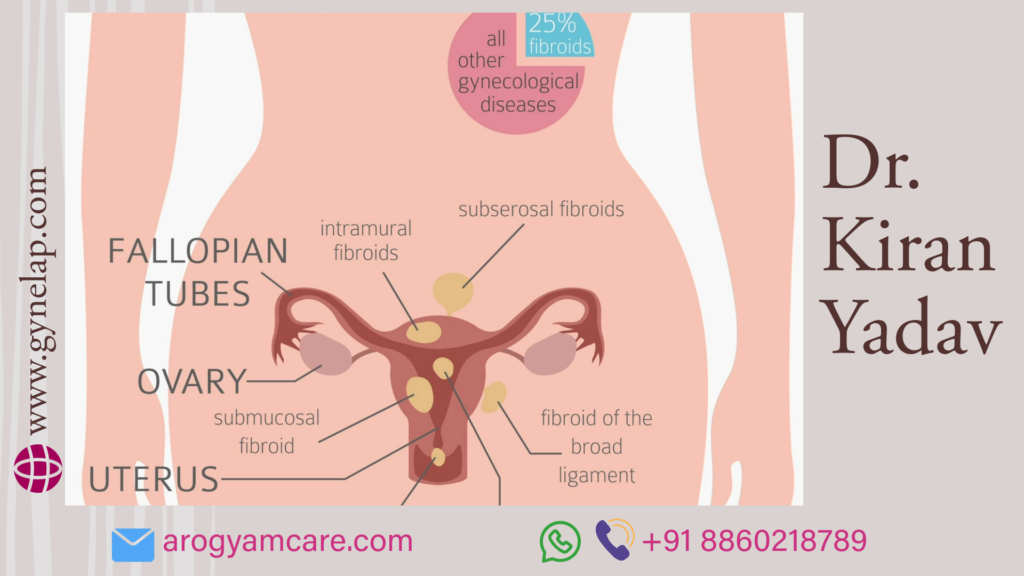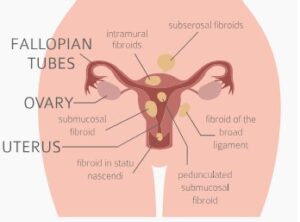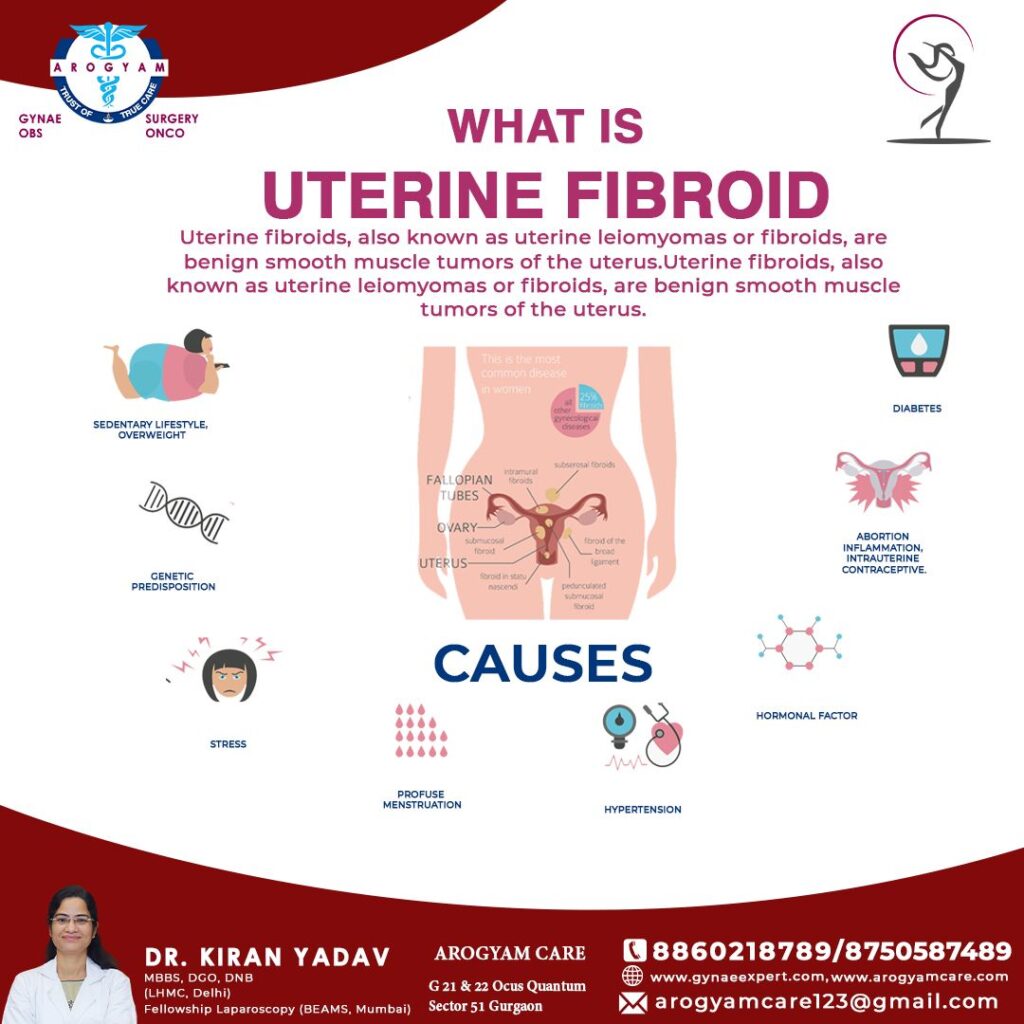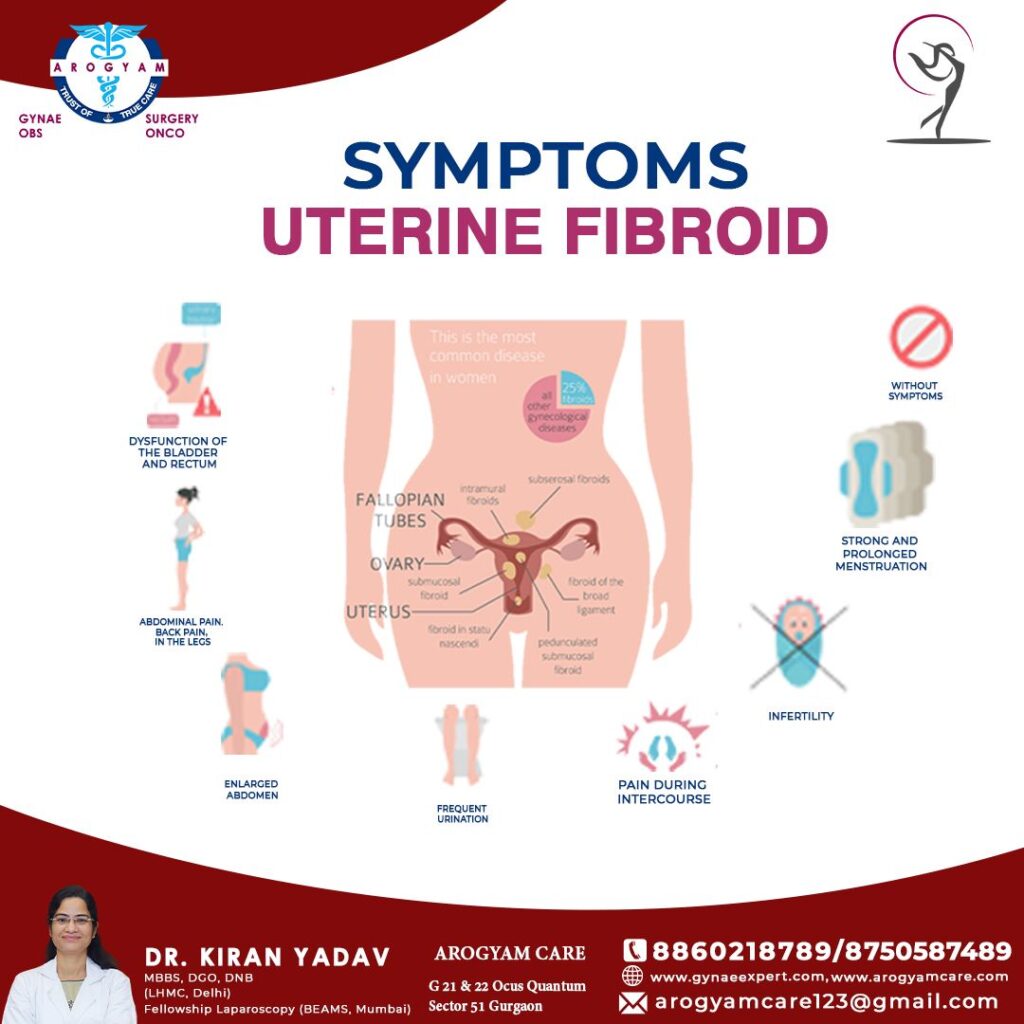Fibroid is vital for every woman to care about her reproductive health. Uterus is shaped like a pear, but its shape keeps changing according to phase in a woman’s life. The most common ailment that afflicts the uterus. Uterine fibroids are noncancerous growths of the uterus. They are also called leiomyomas or myomas. This affects women of childbearing age only. Many women may have it but not know until it is diagnosed.

Cause of Fibroid:
- Age: more common in 30- 50 years.
- Race: more common and tend to be larger and more symptomatic in African.
- Family history
- Obesity: increase the estrogen levels and promote growth.
- Diet: high red meat and low fruits & vegetables increase the risk.
- Lifestyle: high blood pressure, diabetes, or an infection of the uterus
Types of Fibroids
 Fibroids can grow in different locations within the uterus:
Fibroids can grow in different locations within the uterus:
- Intramural: These grow within the muscular wall of the uterus and are the most common type.
- Subserosal: These develop on the outer surface of the uterus and can grow large enough to make the uterus appear bigger on one side.
- Submucosal: These develop just under the lining of the uterine cavity and can cause heavy menstrual bleeding and fertility issues.
- Pedunculated: These are attached to the uterus by a thin stalk and can grow either inside or outside the uterus.
Symptoms of Fibroid
Many women with fibroids experience no symptoms at all. However, when symptoms do occur, they can vary based on the number, size, and location of the fibroids:
- Heavy Menstrual Bleeding: This is one of the most common symptoms, sometimes leading to anemia.
- Pelvic Pain or Pressure: Larger fibroids can cause a feeling of fullness in the lower abdomen or pain.
- Frequent Urination: Fibroids pressing on the bladder can lead to the need to urinate more often.
- Constipation: Pressure on the rectum can make bowel movements difficult.
- Pain During Intercourse: Depending on the location, fibroids can cause discomfort or pain during sexual activity.
- Complications in Pregnancy: Fibroids can sometimes cause complications like miscarriage, preterm birth, or difficulty during delivery.
- Prolonged or irregular menstrual periods: This may cause inconvenience and discomfort.
- Pelvic pressure or pain
- Frequent urination
- Backache or leg pain
- Backache
In some cases, uterine fibroids may cause complications such as:
- Infertility: because of distortion or blockage of the fallopian tubes.
- Miscarriage: because of reduced blood supply to the placenta or abnormal contractions of the uterus.
- Preterm labor: because of increased inflammation or infection in the uterus or premature rupture of membranes.
- Abnormal fetal position: This may happen because of reduced space in the uterus or malformation of the uterus.
- Cesarean delivery: This may be necessary because of obstruction by large or abnormal fetal position.
- Postpartum hemorrhage: This may happen because of poor contraction of the uterus after delivery or retained placenta.
Investigations:
- Ultrasound
- Magnetic resonance imaging (MRI) in large and complex fibroids.
- Hysterosalpingography: It can help detect submucosal and blockage of the tubes.
- Hysteroscopy: This is a procedure that uses a thin, lighted telescope (hysteroscope) to look inside the uterus. It can help diagnose and treat submucosal fibroids and other problems of the uterine lining.
Treatment
Observation- most of the asympotomatic fibroids- do not need any treatment, just observation and Ultrasound every 6 months or yearly.
– Levonorgestral IUD or Mirena – The use of Mirena can lessen symptoms like heavy bleeding. Although it may not lessen the size of fibroid.
Medical methods- GnRH agonists- they induces temporary menopause like phase, as a result menstruation stops, shrink and anaemia improves.
Hysteroscopic myomectomy- If the fibroid is located inside the uterine cavity, it can be treated by hysteroscopy . Hence no cut on abdomen and fast recovery.
Laparoscopic surgery- This comes into picture when no medication works. In this fibroid is removed fully. A surgeon removes it by viewing the fibroid on the screen. This is beneficial as recovery time is quicker than a traditional surgery.
Abdominal myomectomy- sometimes depending upon size and MRI findings doctor can suggest open or traditional surgery too.
Fibroid doesn’t mean you are not normal. One just needs a good treatment.
Living with Fibroids
While fibroids can be challenging, many women manage their symptoms successfully with treatment. Lifestyle changes, such as maintaining a healthy weight, eating a balanced diet, and managing stress, may help reduce the risk of developing fibroids or lessen symptoms.




